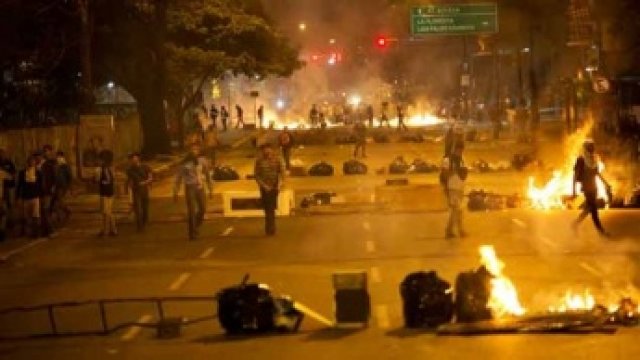
The strategy and tactics of the Venezuelan opposition is a replay of events that took place leading up to the coup against Hugo Chavez on April 11, 2002.
The blatant distortions and in some cases lies of the media — CNN in Spanish playing a lead role — represent an essential element in the strategy.
There are two main groups that the United States-funded right-wing opposition has mobilised. From all appearances, the two act in coordination even though their style, and even social background, differs.
One group is non-violent and the other engages in acts of aggression — in some cases endangering lives.
On the one hand, students and other young people carry out protests that the media and the opposition deceptively call “peaceful”. These mobilisations involve, to a disproportionate extent, students from private universities and operate almost exclusively in wealthy areas whose mayors (and in some cases governors) belong to the opposition.
The protests are not legal, even though many of the protesters are convinced (or have been convinced by their leaders) that they are exercising the constitutional right of dissent.
However, nearly all of these protests take over main avenues and highways in urban areas, typically forcing traffic to a halt and then having to pass through just one lane. It often takes hours for cars to pass through these points.
In most cases, the protesters consist of between 15 and 80 people, and in a few cases more than 100.
The second group then sets up barricades using garbage bags, trees, boulders and barbed wire. They have also used tactics such as pouring oil on roads, in some cases causing fatal accidents.
A March 7 Venezuela Analysis article by Miguel Tinker Salas provides a clear description of these actions in the city of Merida near the Colombian border, where the violence has been most intense. http://venezuelanalysis.com/analysis/10456http://venezuelanalysis.com/analysis/10456.
All efforts by security forces to get both situations under control are portrayed in the private media as fierce acts of repression carried out by police, National Guardsmen, and motorcyclists and other Chavistas organised as “collectives”.
The media generally recognise that some of the opposition protesters have engaged in violence, but attention is focused on the so-called “peaceful protesters”, with little acknowledgment of the chaos they cause.
Furthermore, these reports fail to point out that a large number of the victims, including deaths, are Chavez supporters and security forces. In most violent urban protests throughout the world, the ratio of protesters to security forces who are wounded and killed ranges from 25 to one or 500 to one. Here the ratio may be in the single-digit range.
Claims in the social media that the violent actions are provoked by “infiltrators” (the implication being that the infiltrators are Chavistas) are sometimes reflected in the media.
The script’s end game consists of a large “peaceful” protest that heads to the centre of Caracas with a “vanguard” that creates violence and provokes shootings, resulting in deaths on all sides — protesters, Chavista civilians and security forces. The idea is this will force the government to resign or set off a military coup.
This scenario was exactly what took place on April 11, 2002.
That day, the media and opposition deceptively claimed that the government’s contingency plan, known as “Plan Avila”, consisted of widespread brutal repression. The opposition and media also falsely claimed that armed Chavista groups known as the Bolivarian Circles were poised to violently attack peaceful opposition concentrations — and that these groups even had tanks at their disposal.
There were about 20 deaths on the day — both Chavistas and opposition. This was the excuse to carry out a military coup, which the government of George W Bush (which as documents demonstrate knew perfectly well who was behind the killings) used to justify its support for the de facto government led by Chamber of Commerce head Pedro Carmona.
An uprising by the poor and loyal soldiers restored Chavez to power by April 14.
The Chavista government has learned from that experience. President Nicolas Maduro and the mayor of Caracas’s Libertador municipality, where the popular sectors are concentrated, have adamantly refused to allow opposition demonstrators to go from the wealthy eastern part of Caracas to the downtown area.
Time and time again, the protesters organise marches designed to reach the city’s centre even though they have not been given permits.
CNN and the media in general harp on about the government’s failure to issue a marching permit as an example of the restriction on democratic liberty. They fail to mention the government has good reason to prevent marches from reaching the downtown area.
The phony issue of government repression raised by the opposition and the private media is an essential part of the script. Without this issue, there is really no justification for the opposition’s sole demand for regime change embodied in the slogan “salida” (exit).
Certainly there are pressing problems in Venezuela, including shortages of basic (and some non-basic) commodities, inflation and delinquency. But these problems do not justify the overthrow of the government. If these were the issues, people in general would say “wait until the next elections and vote the Chavistas out of office”.
The opposition’s strategy is to either create conditions that may set off a coup — which is highly unlikely given the military’s well demonstrated loyalty to the government and constitution — or (much more likely) to wear out the population so in the next elections, voters back opposition candidates who distance themselves from the violence allegedly coming from both sides.
[Steve Ellner is a professor at the Universidad de Oriente in Puerto La Cruz, Venezuela, and also teaches in the government’s university-based Sucre Mission.]